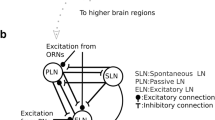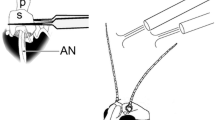Summary
-
1.
Responses of neurons in the antennal lobe (AL) of the mothManduca sexta to stimulation of the ipsilateral antenna by odors consist of excitatory and inhibitory synaptic potentials (Fig. 2A). Stimulation of primary afferent fibers by electrical shock of the antennal nerve causes a characteristic IPSP-EPSP synaptic response in AL projection neurons (Fig. 2B).
-
2.
The IPSP in projection neurons reverses below the resting potential (Fig. 3), is sensitive to changes in external (Fig. 4) and internal (Fig. 5) chloride concentration, and thus is apparently mediated by an increase in chloride conductance.
-
3.
The IPSP is reversibly blocked by 100 μM picrotoxin (Fig. 6) or bicuculline (Fig. 7).
-
4.
Many AL neurons respond to application of GABA with a strong hyperpolarization and an inhibition of spontaneous spiking activity (Fig. 8). GABA responses are associated with an increase in neuronal input conductance (Fig. 9) and a reversal potential below the resting potential (Fig. 11).
-
5.
Application of GABA blocks inhibitory synaptic inputs (Fig. 12 A) and reduces or blocks excitatory inputs (Fig. 12B). EPSPs can be protected from depression by application of GABA (Fig. 12B).
-
6.
Muscimol, a GABA analog that mimics GABA responses at GABAA receptors but not at GABAB receptors in the vertebrate CNS, inhibits many AL neurons in the moth (Fig. 13).
Similar content being viewed by others
Abbreviations
- AL :
-
antennal lobe
- BMI :
-
bicuculline methiodide
- IACT :
-
inner antenno-cerebral tract
- LY :
-
Lucifer Yellow
References
Abalis IM, Eldefrawi ME, Eldefrawi AT (1983) Biochemical identification of putative GABA/Benzodiazepine receptors in housefly thorax muscles. Pestic Biochem Physiol 20:39–48
Bell RA, Joachim FA(1976) Techniques for rearing laboratory colonies of tobacco hornworms and pink bollworms. Ann Entomol Soc Am 69:365–373
Bowery NG, Hill DR, Hudson AL (1983) Characteristics of GABAB receptor binding sites on rat whole brain synaptic membranes. Br J Pharmacol 78:191–206
Breer H, Heilgenberg H (1985) Neurochemistry of GABAergic activities in the central nervous system ofLocusta migratoria. J Comp Physiol A 157:343–354
Bryan JS, Krasne FB (1977) Presynaptic inhibition: the mechanism of protection from habituation of the crayfish lateral giant fibre escape response. J Physiol 271:369–390
Callec JJ (1974) Synaptic transmission in the central nervous system of insects. In:Treherne JE (ed) Insect neurobiology. Elsevier, New York, pp 119–185
Christensen TA, Hildebrand JG (1987a) Functions, organization, and physiology of the olfactory pathways in the lepidopteran brain. In: Gupta AP (ed) Arthropod brain: Its evolution, development, structure and functions. Wiley and Sons, New York (in press)
Christensen TA, Hildebrand JG (1987b) Male-specific, sex pheromone-selective projection neurons in the antennal lobes of the mothManduca sexta. J Comp Physiol (in press)
Christensen TA, Waldrop BW, Hildebrand JG (1985) GABAmediated inhibition in the antennal lobes of the mothManduca sexta. Soc Neurosci Abstr 11:163
Constanti A (1978) The ‘mixed’ effect of picrotoxin on the GABA dose/conductance relation recorded from lobster muscle. Neuropharmacol 17:159–167
DeFeudis FV (1977) GABA-receptors in the vertebrate nervous system. Prog Neurobiol 19:123–145
DeFeudis FV, Ossola L, Schmitt G, Mandel P (1980) Substrate specificity of [3H]muscimol binding to a particulate fraction of a neuron-enriched culture of embryonic rat brain. J Neurochem 34:854–849
Dunlap K (1981) Two types ofγ-aminobutyric acid receptor on embryonic sensory neurones. Br J Pharmacol 74:579–585
Enna SJ (1983) GABA receptors. In: Enna J (ed) The GABA receptors. Humana Press, New York, pp 1–23
Gregory LJ, Djamgoz Mustafa BA, Irving SN (1985) GABAergic inhibition of ventral nerve cord activity in the cockroach. In: Insect neurobiology and pesticide action (Neurotox '85). Soc Chem Ind, London, pp 73–74
Harrow ID, Hildebrand JG (1982) Synaptic interactions in the olfactory lobe of the mothManduca sexta. Soc Neurosci Abstr 8:528
Hildebrand JG (1985) Metamorphosis of the insect nervous system. Influences of the periphery on the postembryonic development of the antennal sensory pathway in the brain ofManduca sexta. In: Selverston A (ed) Model neural networks and behavior. Plenum Press, NY, pp 129–148
Hildebrand JG, Montague RA (1986) Functional organization of olfactory pathways in the central nervous system ofManduca sexta. In: Payne T, Birch MC, Kennedy CEJ (eds) Mechanisms in insect olfaction. Oxford University Press, Oxford London, pp 279–285
Hoskins SG, Homberg U, Kingan TG, Christensen TA, Hildebrand JG (1986) Immunocytochemistry of GABA in the antennal lobes of the sphinx mothManduca sexta. Cell Tissue Res 244:243–252
Hue B, Callec JJ (1983) Presynaptic inhibition in the cerealafferent giant-interneurone synapses of the cockroach,Periplaneta americana L. J Insect Physiol 29:741–748
Kerkut GA, Pitman RM, Walker RJ (1969) Iontophoretic application of acetylcholine and GABA onto insect central neurone cell bodies. Comp Biochem Physiol 31:611–633
Kingan TG, Hildebrand JG (1985)γ-aminobutyric acid in the central nervous system of metamorphosing and matureManduca sexta. Insect Biochem 15:667–675
Lees G, Neumann R, Beadle DJ, Benson JA (1985) Flunitrazepam enhances GABA and muscimol-induced responses in freshly dissociated locust central neuronal somata. In: Neuropharmacology and pesticide action (Neurotox '85). Soc Chem Ind, London, pp 108–109
Lummis SCR, Sattelle DB (1985) Insect central nervous systemγ-aminobutyric acid receptors. Neurosci Lett 60:13–18
Lummis SCR, Sattelle DB (1986) Binding sites for [3H]GABA, [3H]flunitrazepam and [35S]TBPS in insect CNS. Neurochem Int 9:287–294
Lunt GG, Robinson TN, Miller T, Knowles WP, Olsen RW (1985) The identification of GABA receptor binding sites in insect ganglia. Neurochem Int 7:751–754
Mann E, Enna SJ (1980) Phylogenetic distribution of bicuculline-sensitiveγ-aminobutyric acid (GABA) receptor binding. Brain Res 184:367–373
Matsumoto SG, Hildebrand JG (1981) Olfactory mechanisms in the mothManduca sexta: response characteristics and morphology of central neurons in the antennal lobes. Proc R Soc Lond B 213:249–277
Maxwell GD, Tait JF, Hildebrand JG (1978) Regional synthesis of neurotransmitter candidates in the CNS of the mothManduca sexta. Comp Biochem Physiol 61C: 109–119
Meiners BM, Kehoe P, Shaner DM, Olsen RW (1979)γ-aminobutyric acid receptor binding and uptake in membrane fractions of crayfish muscle. J Neurochem 32:979–990
Newberry NR, Nicoll RA (1984) Direct hyperpolarizing action of baclofen on hippocampal pyramidal cells. Nature 308:450–452
Nistri A, Constanti A (1979) Pharmacological characterization of different types of GABA and glutamate receptors in vertebrates and invertebrates. Prog Neurobiol 13:117–235
Olsen RW, Ban M, Miller T (1976) Studies on the neuro-pharmacological activity of bicuculline and related compounds. Brain Res 102:283–299
Pichon Y, Sattelle DB, Lane NJ (1972) Conduction processes in the nerve cord of the mothManduca sexta in relation to its ultrastructure and haemolymph ionic composition. J Exp Biol 56:717–734
Pitman RM, Kerkut GA (1970) Comparisons of the actions of iontophoretically applied acetylcholine and gamma aminobutyric acid with the EPSP and IPSP in cockroach central neurons. Comp Gen Pharmacol 1:221–230
Roberts CJ, Krogsgaard-Larsen P, Walker RJ (1981) Studies of the action of GABA, Muscimol and related compounds onPeriplaneta andLimulus central neurons. Comp Biochem Physiol 69C:7–11
Robinson T, MacAllan D, Lunt G, Battersby M (1986)γ-aminobutyric acid receptor complex of insect CNS: characterization of a benzodiazepine binding site. J Neurochem 47:1955–1962
Sanes JR, Hildebrand JG (1976) Structure and development of antennae in a moth,Manduca sexta. Dev Biol 51:282–299
Shank RP, Pong SF, Freeman AR, Graham LT (1974) Bicuculline and picrotoxin as antagonists ofγ-amino-butyrate and neuromuscular inhibition in the lobster. Brain Res 72:71–78
Simmonds MA (1982) Classification of some GABA antagonists with regard to site of action and potency in slices of rat cuneate nucleus. Eur J Pharmacol 80:347–358
Simmonds MA (1983) Multiple GABA receptors and associated regulatory sites. Trends Neurosci 6:279–281
Takeuchi A, Onodera K (1972) Effect of bicuculline on the GABA receptor of the crayfish neuromuscular junction. Nature New Biol 236:55–56
Tolbert LP, Hildebrand JG (1981) Organization and synaptic ultrastructure of glomeruli in the antennal lobes of the mothManduca sexta: a study using thin sections and freeze-fracture. Proc R Soc Lond B 213:279–301
Wafford KA, Sattelle DB (1986) Effects of amino acid transmitter candidates on an identified insect motoneurone. Neurosci Lett 63:135–140
Waldow U (1977) CNS units in cockroach (Periplaneta americana): Specificity of response to pheromones and other odor stimuli. J Comp Physiol 116:1–17
Walker RJ, Crossman AR, Woodruff GN, Kerkut GA (1971) The effect of bicuculline on the gamma-aminobutyric acid (GABA) receptors of neurones ofPeriplaneta americana andHelix aspersa. Brain Res 33:75–82
Author information
Authors and Affiliations
Rights and permissions
About this article
Cite this article
Waldrop, B., Christensen, T.A. & Hildebrand, J.G. GABA-mediated synaptic inhibition of projection neurons in the antennal lobes of the sphinx moth,Manduca sexta . J. Comp. Physiol. 161, 23–32 (1987). https://doi.org/10.1007/BF00609452
Accepted:
Issue Date:
DOI: https://doi.org/10.1007/BF00609452




